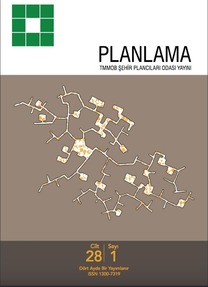Green Settlement Planning and Design: The First National and Institutional Certification Attempt for Turkey
___
BREEAM Official Web Page, Numbers of Project By Countries. (2018). https://tools.breeam.com/projects/explore/map.jsp?sectionid=0&pro -jectType=&rating=&certNo=&buildingName=&client=&developer =&certBody=&assessor=&addressPostcode=&countryId=7&partid =10023&Submit=Search.Erten D., Henderson K., Kobas B. (2009). A Review of International Green Building Certification Methods: A Roadmap for a Certification System in Turkey. Fifth International Conference on Construction in the 21st Century (CITC-V). Act. No.6306 of Turkish Law, 2012. http://www. resmigazete.gov.tr/eskiler/2016/10/ 20161027-2.htm.
Hamedani A.Z. & Huber F. (2012). A Comperative Study of DGNB, LEED and BREEAM Certificate Systems in Urban Sustainability. The Sustain -able City VII. (Vol I, pp.121-132).
Kibert C.J. (2013). Sustainable Construction: Green Building Design and De -livery (Third Edition). Wiley and Sons: New Jersey.
LEED Official Web Page. Numbers of Project by Countries. (2018). https:// www.usgbc.org/articles/usgbc-announces-international-ranking-top10-countries-leed.
Official Journal (o.j). (2017, 23 December). No: 30279. http://www. resmigazete.gov.tr/ eskiler/ 2017/12/20171223-3.htm.
Ozcevik O., Oguz M., Akbulut A. (2018). Urban Transformation and Green Certification Systems in Combating Climate Change. İ.T.Ü Foundation Journal. (Vol 80, pp.34-39).
Ringel M. (2006). Fostering the Use of Renewable Energies in the European Union: the Race between Feed-in Tariffs and Green Certificates. Renew -able Energy. (Vol 31, Issue 1, pp. 1-17).
Sharifi A. & Murayama A. (2014). Neighbourhood Sustainability Assess -ment in Action: Cross-evaluation of Three Assessment Systems and Their Cases from the US, the UK, and Japan. Building and Environment. (Vol 72, pp. 243-258).
Steffen, W., Richardson, K., Rockström, J., Cornell, S.E., Fetzer, I., E.M. Ben -nett, Biggs, R., S.R. Carpenter, De Vries, W., De Wit, C.A., Folke, C., Gerten, D., Heinke, J., Mace, G.M., Persson, L.M., Veerabhadran, R., Reyers B. & Sörlin S. (2015). Planetary Boundaries: Guiding Human Development on A Changing Planet. Science (Vol 347 (6223), pp.736- 748).
The Ministry of Energy and Natural Resources. (2018). National Energy Efficiency Action Plan 2017-2023.
http://www.yegm.gov.tr/document/20180102M1_2018.pdf.
TurkStat. (2016). Energy Statistics. http://www.tuik.gov.tr/Start.do.
TurkStat. (2017). Foreign Trade Statistics. http://www.tuik.gov.tr/Start.do.
TurkStat. Greenhouse Emission Statistics 1990-2015. http://www.tuik.gov. tr/Start.do.
Union of Turkish Bar Associations. (2014). International Natural Pro -tection Agreements. http://www.cmo.org.tr/resimler/ekler/ 0a964846d55e228_ek.pdf.
United Nations Sustainable Goals 2016 Report. https://sustainabledevelop -ment.un.org/ content/ documents/ 21252030%20Agenda %20for%20 Sustainable%20 Development %20web.pdf.
Wamsler C., Brink E., Rivera C. (2013). Planning for Climate Change in Ur -ban Areas: From Theory to Practice. Journal of Cleaner Production (Vol 50 (1), pp.68-81).
- ISSN: 1300-7319
- Yayın Aralığı: 3
- Başlangıç: 1986
- Yayıncı: TMMOB Şehir Plancıları Odası
Kentsel Dönüşüm Uygulamalarında Kurumsal Kapasite Yaratmanın Önemi
Kartografik Analiz ve Rehberli Gezi Yöntemleriyle Peyzaj Değişiminin Tespiti: İzmir Selçuk Örneği
ÖZLEM ÖZÇEVİK, MELİS OĞUZ, AYŞE AKBULUT
Emin Yahya MENTEŞE, AZİME TEZER, Mehmet DEMİR
Konut Üretim Performansının Konuta Ekonomik Erişebilirlik Üzerindeki Etkisinin İncelenmesi
